【教育学习文章】上海牛津英语3B教案
上海牛津英语3B教案
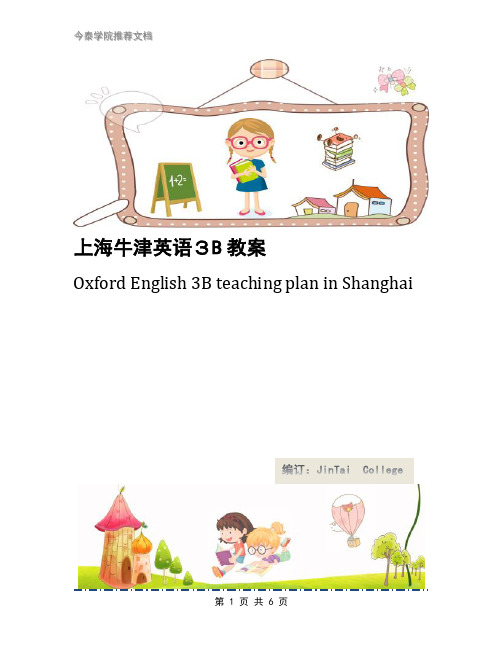
上海牛津英语3B教案Oxford English 3B teaching plan in Shanghai上海牛津英语3B教案前言:小泰温馨提醒,英语作为在许多国际组织或者会议上都是必需语言,几乎所有学校选择英语作为其主要或唯一的外语必修课。
英语教学涉及多种专业理论知识,包括语言学、第二语言习得、词汇学、句法学、文体学、语料库理论、认知心理学等内容。
本教案根据英语课程标准的要求和针对教学对象是小学生群体的特点,将教学诸要素有序安排,确定合适的教学方案的设想和计划、并以启迪发展学生智力为根本目的。
便于学习和使用,本文下载后内容可随意修改调整及打印。
module 1 unit 1 1st hourteaching aims:1.to develop an awareness and an enjoyment of the basic sounds of englishthrough saying a poem. (eda)2.to respond to something through making a simple object. (edb)3.to obtain and provide objects and information through simple interactivegames. (ide)education aims: good habits.teaching focus:ing nouns to identify different parts of the bodye.g. noseing modal verb ‘can/can’t to talk aboutabilitye.g. i can’t see.teaching aids:a tape-recorder、 a picture、 a small mirrorteaching procedure:purposestep one: warming up1.sing a song 《hide and seek》.2.greetings each other.step two: new teaching1.introduce: eyes, ears, mouth, nose, hair by pointing at these parts of your body. put the picture on the board.2.write: eyes, ears, mouth, nose, hair on the board. read after the teacher.3.t say: touch your nose/ears/eyes/hair/mouth. p act.4.hold a small mirror a nd ask :what’s this? p answer. {a mirror}.learn the word.a. read after me.b. read one by one.c. spell the word.5.ask a student to look in the mirror. ask: what can you see? toelicit: eyes/ears/mouth/nose/hair p-p work in pairs.6.please open your books at page 2.listen and read after the recording.invite individual students to say the poem.7.divide the class into groups. ask students to follow the instructions in the student’s book and mask a mask.8.play the cassette: look and say. the students follow in their books.9.one student in each group wears the mask. the others ask: what can you see? to elicit: i can’t see. then, they put some objects on a desk.the student with a mask asks each member of the group: what can you see? to elicit: i can see a/an-(classroom object)step three: activities1.workbook page 1a. ask students to read the given words with you.b. the students match and write.c. check answers by inviting students to label a face on the board.d. the students draw and label a face. encourage them to share theirwork with other students. less able students can take this chanceto correct their work.2.play simon says …with the students using eyes, ears, mouth, nose andhair.step four: consolidationgrammar practice book 3b page 1 .step five: homeworkread the poem.homework:1.write the new words 4 times each one.2.read the book p 1.-------- Designed By JinTai College ---------。
牛津小学英语3B全册第一单元教案

牛津小学英语3B全册第一单元教案牛津小学英语3B第一单元教案第一课时一、教学内容《牛津小学英语》3B第一单元第一课时二、教学目标、能听懂、会说文具玩具类单词aschoolbag,acrayon,atape,aknife2、能听懂、会说日常交际用语what’sthis/thatinEnglish?It’s…3、能使用礼貌用语Excuseme.三、教学重点、能听懂、会说文具玩具类单词aschoolbag,acrayon,atape,aknife四、教学难点、能听懂、会说文具玩具类单词aschoolbag,acrayon,atape,aknife2、能听懂、会说日常交际用语what’sthis/thatinEnglish?It’s…Excuseme.并获得运用语言进行交际的能力,要求读音正确,语调自然。
五、课前准备教具准备:课前准备本课的文具玩具图片和实物若干。
人物图片(yangLing,GaoShan.)及磁带录音机,教学挂图。
六、教学过程Step1.Freetalk:.师生用Goodmorning/afternoon.Howareyou?互相问候。
2.引导学生用what’syourname?互问姓名,练习“what’s”。
3.出示本课的人物图片,示范:ThisisyangLing.That’sGaoShan.出示水果类图片,引导学生用Thisisa...That’sa...It’sa...造句。
Step2.Presentationandpractice、出示文具类图片(pen,book等学过的单词)让学生造句:Thisisa...That’sa...It’sa...2、出示一只书包T:what’sthis?S:Abag.T:It’saschoolbag.出示单词aschoolbag并领读S:跟读T:what’sthisinEnglish?S:It’saschoolbag.出示词组inEnglish并领读S:跟读T:what’sthisinEnglish?S:跟读。
(沪教版)三年级牛津英语教案3BModule3Unit3
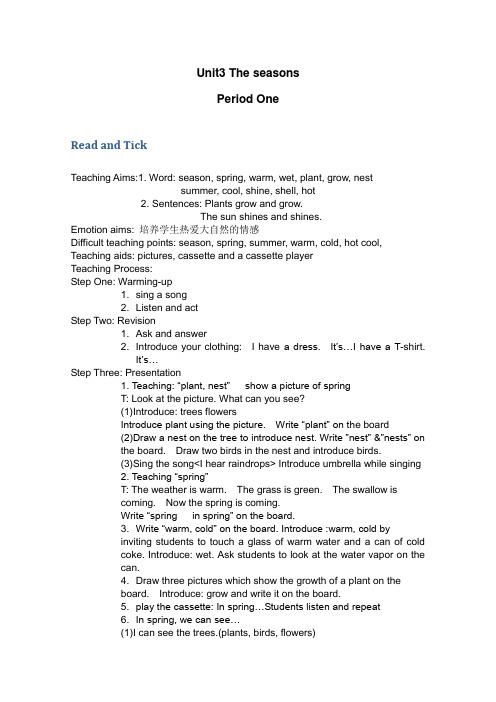
Unit3 The seasonsPeriod OneRead and TickTeaching Aims:1. Word: season, spring, warm, wet, plant, grow, nestsummer, cool, shine, shell, hot2. Sentences: Plants grow and grow.The sun shines and shines.Emotion aims: 培养学生热爱大自然的情感Difficult teaching points: season, spring, summer, warm, cold, hot cool, Teaching aids: pictures, cassette and a cassette playerTeaching Process:Step One: Warming-up1. sing a song2. Listen and actStep Two: Revision1. Ask and answer2. Introduce your clothing: I have a dress. It’s…I have a T-shirt.It’s…Step Three: Presentation1. Teaching: “plant, nest” show a picture of springT: Look at the picture. What can you see?(1)Introduce: trees flowersIntroduce plant using the picture. Write “plant” on th e board(2)Draw a nest on the tree to introduce nest. Write ”nest” &”nests” onthe board. Draw two birds in the nest and introduce birds.(3)Sing the song<I hear raindrops> Introduce umbrella while singing2. Teaching “spring”T: The weather is warm. The grass is green. The swallow iscoming. Now the spring is coming.Write “spring in spring” on the board.3. Write “warm, cold” on the board. Introduce :warm, cold byinviting students to touch a glass of warm water and a can of coldcoke. Introduce: wet. Ask students to look at the water vapor on thecan.4. Draw three pictures which show the growth of a plant on theboard. Introduce: grow and write it on the board.5. play the cassette: In spring…Students listen and repeat6. In spring, we can see…(1)I can see the trees.(plants, birds, flowers)(2)In spring, we can’t see umbrellas.(3)In spring, is the weather cold? No, it’s warm.warm---coolIn spring, it’s wet. Plants grow and grow.7. Teaching : summer ,shellsShow summer on the picture. Encourage the students to predictwhat they can see in summer and tick the appropriate boxes.Introduce: shells , summer Write them on the board8. Play the cassette: In summer…Students listen and check theprediction.9. Write hot, cool on the board. Introduce: hot, cool by invitingstudents to touch a glass of hot water and a can of cool coke.10. Draw: the sun on the board. Introduce: shines by drawing linesout from the sun. Add a match stick figure wearing a pair ofsunglasses.Step Four: Consolidation1. Divide students into groups. Invite each group to read page36aloud.Step Five: Homework1. Listen to the tape2. Copy the wordsPeriod TwoRead and TickTeaching Aims: 1. Words: dry, fall, autumn, bicycle, scarf, winter, wind, gloves2. Sentences: Leaves fall and fall.The wind blows and blows.Emotion aims: 培养学生热爱大自然的情感Difficult teaching points: autumn, winter, dry, scarves, gloves,windTeaching aids: pictures, cassette and a cassette playerTeaching Process:Step One: Warming-up1. Listen and act2. Ask and answerStep Two: Revision1. In spring, what can you see? I can see…/ I can’t see…How is the weather in spring? Is it cold?2. Read “In spring”3. In summer, what can you see? I can see…/I can’t see…4. Read “In summer”Step Three: Presentation1. Teaching “autumn, dry”Show the picture of autumn.(1)What can you see? I can see kites, slides, bicycles…Is it spring? No, it isn’t. It is autumnWrite “autumn in autumn” on the board.Say after teacher(2)Soak a tissue with water. Ask students to feel the wet tissue and adry one. Introduce: dry2. Teaching :fallIntroduce: fall by drawing some falling leaves. Add an arrow toshow that they are falling down from the tree to the ground.Say : Leaves fall and fall3. Play the cassette: In autumn…Student s listen and repeat4. Look at the picture, ask and answer(1)In autumn. What can you see?We can see… We can’t see…(2)Is it hot(cool, warm, wet, dry)? Yes, it is. No, it isn’t.5. Teaching: winter, scarves,glovesShow the picture of autumn.(1)What can you see? I can see hats, coats…Is it autumn? No, it isn’t. It is winterWrite “winter in winter” on the board.Say after teacher(2) Introduce: gloves scarves using the pictureWrite “scarf scarves” on the board6. Teaching :wind ,blow(1)T: In winter, is it hot? No, it’s cold. Is it wet? No, it’s dry.Imitating the sounds of the wind and draw some lines on theboard to introduce “wind”What can you hear? Write wind on the board(2)Ask students to imitate the sounds of the wind loudly orquietly. Introduce: The wind blows and blows.7. Play the cassette: In winter…Students listen and repeat8. Look at the picture, ask and answer(1)In winter. What can you see?We can see… We can’t see…(2)Is it hot(cool, warm, wet, dry)? Yes, it is. No, it isn’t. Step Four : Consolidation1. Listen to the tape2. Tick the correct boxStep Five: Homework1. Listen to the tape2. Write down the sentencesPeriod ThreePlay a game Learn the soundsTeaching Aims: 1.Asking “wh-“ques tions to find out the time of year2. Asking “yes/no” question to obtain simple responses3.Learn the sound // //Emotion aims: 要求学生大胆模仿,善于观察Difficult teaching points: What season is it? Is it winter?Yes, it is. / No, it isn’t.Teaching aids: pictures, cassette and a cassette playerTeaching Process:Step One: Warming-up1. Sing a song.2. Ask and answerStep Two: Revision1. Read the new words2. Answer the following questions:In spring, what can you see?What can you see in summer?What can you see in autumn?In winter, what can you see?3. warm---cool hot---cold wet---dry4. Tick the correct boxseason warm cool hot cold wet drySpringSummerAutumnStep Three: Presentation1. Teaching : What season is it?(1)Look at the picture. We can see plants. We can hear theraindrops. IWhat season is it? To elicit: Is it spring?(summer)(2) It is wet. It is warm. What season is it? To elicit: Is itspring(summer)?(3) Write “What season is it ?” on the board. Ask and answer/eg: S1:It is wet. It is hot. What season is it?S2: Is it summer?S3: Yes, it is.2. Tell students that there are four seasons in a year. Invite them tolist the four seasons on the board.3. Pretend to be swimming. Ask students to look at the book of page38 and see in which season characters are dong the same thing asyou. Ask and answer.4. Invite individual students to come to the board and demonstratethe actions of the characters on the book. Prompt those students to ask:What season is it? To elicit guesses from the class: Is it…? They thenrespond to their classmates’ guesses: Yes, it is./No, it isn’t.5. Play the cassette. Students listen and repeat.6. Ask and answer(1) Which do you like? Spring or summer? Why?(2) Which season do you like best? Why?7. Learn the sound // //(1)Play the cassette. Students listen(2)Play the cassette again. Students listen and repeat.(3) Find out the words of the sound // //(4) Read the sentences loudStep Four: Consolidation1. Workbook page282. Grammars practice book page37Step Five: Homework1. Listen to the tape2. Copy the words课后随笔Period FourLook and sayTeaching Aims: 1.New words: his, her2. Asking “wh-” question to obtain simple responses3. Using pronouns to refer to people and thing.Emotion aims: 教育学生要有助人为乐,相互关心的好品质Difficult teaching points: his herThat’s his/ her …Teaching aids: pictures, different objects, cassette and a cassette player Teaching Process:Step One: Warming-up1. Sing a song.2. Ask and answerStep Two: Revision1. Review: my your by holding up your belongings and yourstudents’ belongings. Say: This is my… That is your …Students work in pairs2. Ask: Is this my…? Is this your… to elicit Yes, it is. / No, it isn’t.Students ask and answerStep Three: Presentation1. Teaching: his her That’s hie/her…(1) Invite students to put their belongings on the teacher’s desk.(2) Introduce : That’s (a boy’s name) …. That’s his …by pointingat that boy as well as his belongings on the desk.Write “his ” on the board.(3) Introduce: That’s (a girl’s name) …. That’s her …by pointingat that girl as well as her belongings on the desk.Write “her ” on the board.(4). Students work in pairs That’s (a student’s name). That’shis/her …2. Teaching: Here’s your…Return the belongings to th e owners and say Here’s your…to elicit:Thank you./ Thanks3. Teaching: Where’s my…?Hide one belonging in one student’s desk and ask: Where’s my ,…?To elicit: Here it is./ Here you are.Students work in pairs.4. Play the cassette. Students listen and follow in their books.5. Play the cassette again. Students repeat.6. Divide students into groups to act the story.7. Students vote for the best group.8. Encourage students make a new storyStep Four: Consolidation1. Play the cassette the third time. Ask the students to read the pageand fill in the blanks.2. Students work in pairs to check answers.3. Invite individual students to point at the pictures on the page andread a loud the sentences in Point and say.4. Exercise: Write my ,your, his or her(1) This is Ben. This is _______bicycle.(2) I am Kitty. ______ bag is blue(3) She’s Alice. That’s _____ umbrella.(4) You are Mr Li. ______ car is black.(5) Is this ______ hat? Yes, it’s my hat.(6) That’s my mother. That’s _____ coat.(7) Where’s ______ scarf? Here you are.(8) He’s Mr Wang. _____ gloves are new.Step Five: Homework1. Listen to the tape2. Work book page30 31Period FiveSay and actTeaching Aims: 1. Using imperatives to give instructions2. Asking “wh-” question to find out the time of year3. Using predicative adjectives to describe conditionsEmotion aims: 鼓励学生与他人的交流,发表自己的观点Difficult teaching points: Use appropriate intonation in questions and statements Teaching aids: pictures, photograph, cassette and a cassette playerTeaching Process:Step One: Warming-up1. sing a song2. Read the wordsStep Two: Revision1. Show students pictures of four seasons.Ask and answer(1)What can you see in spring/summer/autumn/winter?(2)Is it hot / cold / warm / cool?(3)Is it wet / dry?(4)It is hot. We can see shells. What season is it?(5)Do you like spring?(6)Which season do you like best? Why2. Invite students to say the rhyme: Four seasonsEncourage individual students to say the rhymeStep Three: Presentation1. Encourage students to say : In spring / summer / autumn / winter,it’s…/ We can see…2. Show a photograph and say: Look at the photograph. To elicit : Whois he/she. Then answer: He’s my…/She’s my …Take out studen t’s photograph and introduce the person in thephotograph.Students work in pairs. Ask and answer.3. Talk about the season4. Ask : Do you like …(season)?5. Play the dialogue on the cassette while students follow in theirbooks. Students content through listening.6. Play the dialogue in four parts. Students follow the tape and repeat.7. Divide students in pairs. Ask them to act out the dialogue.8. Encourage the more able students to make a new dialogue.eg: S1: Look at this photograph. Who is she?S2: She’s my big sister, Rose.S1: What season is it?S2: It is summer. It’s hot. The sun is shining. Rose has herblue sunglasses.S2: She has a nice dress. It is pink.S1: I like summer. It’s hot. I like swimming. I like ice-creams.Do you like summer?S2: No, I don’t like it. I like autumn. I like kites. It is not hot.It is cool.S1: But in autumn it is dry. The leaves fall.S2: Yes, it is.Step Four: ConsolidationWorkbook page321. Students first work in pairs to finish the exercises orally. Theyneed to look at each picture, and find the corresponding word fromthe centipede.2. Students write the correct words in the blanks provided.3. Students exchange their work and check answers.Step Five: Homework1. Listen to the tape2. Write 5 sentences about your favorite season.。
上海牛津英语3BM2U1教案

教学准备
Multimedia, tape …
Procedures
Step
Teacher’s activities
Purpose
Pre-task preparation
Wห้องสมุดไป่ตู้rming up
1. Revision of the animals.
1Look and say
Show a picture of monkeys and ask some questions.
Look at the picture. What can you see"
What can they do"
Do you like monkeys"
2Look at page 16 and talk about the pictures.
2. 重复操练本课句型及对话容
2.
通过看,听,说等师生,生生交互活动,在模仿—操练—稳固中,让学生熟练地运用所学句型及单词进展交际性的操练,到达学以致用的目的.
3.
通过学习故事,感受故事的趣味性及情节美。
教学重,难点
1. Using yes/no questions to elicit a positive or negative response. eg. Do you like it" Yes,Ido. / No, I don’t.
2. Song
Show the pictures of some farm animals and wild animals.
Ask the students to listen carefully and answer your questions.
牛津小学英语3B全册教案

牛津小学英语3B全册第10单元教案牛津小学英语3B第10单元教案一教学内容牛津小学英语 3B第10单元二教学目标 1、能正确地听、说、读、写字母Uu, Vv, Ww.2、能听懂、会说乐器和球类单词:a piano, a violin, a guitar, an accordion, football, basketball, volleyball, baseball及其词组play (the)… .3、能听懂、会说日常交际用语Do you play…? Do you like…? Yes, I do. /No, I don’t. What do you play? I play…. Great!并能熟练运用日常交际用语进行问答。
4、能区分球类和乐器的表述方法,并能熟练运用。
5、欣赏歌曲We study and play. 三教学重点 1 能正确地听、说、读、写字母Uu, Vv, Ww. 2、能听懂、会说乐器和球类单词及其词组。
3、能听懂、会说日常交际用语Do you play…? Do you like…? Yes, I do. /No, I don’t. What do you play? I play… Great!并能熟练运用日常交际用语进行问答。
四教学难点 1、能区分球类和乐器的表述方法,并能熟练运用。
2、初步感知第三人称单数的用法。
3B第十单元第一课时一、教学内容:牛津小学英语 3B第十单元第一课时二、教学目标: 1、能听懂、会说日常交际用语:Do you like football? What do you like? 以及相应的回答Yes, I do./No, I don’t. 2、能听懂、会说球类的单词:football, volleyball, baseball, basketball. 渗透: Ping pong. 3、了解某人的喜好。
4、能够朗读课文。
5、学会创新三、教学重点:单词的朗读及能在情景中运用句型:Do you like …. What do you like? 四、教学难点: What do you like?以及相应的回答Yes, I do./No, I don’t. 五、课前准备: 1、磁带及录音机。
上海版本牛津英语3b学习教案全册.doc
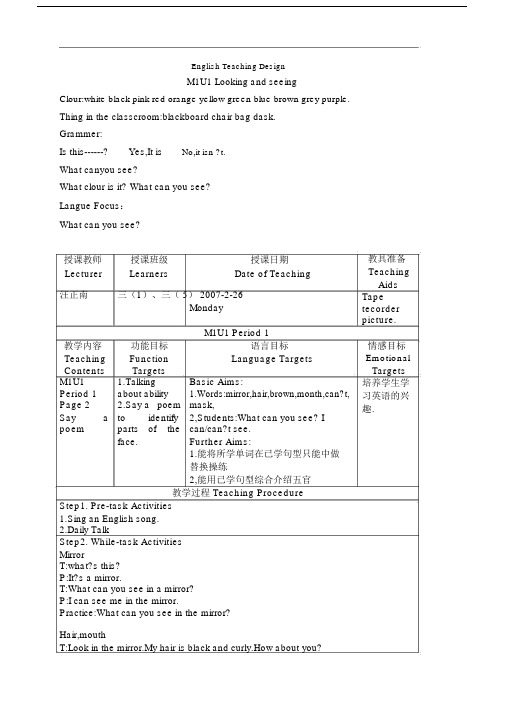
English Teaching DesignM1U1 Looking and seeingClour:white black pink red orange yellow green blue brown grey purple. Thing in the classcroom:blackboard chair bag dask.Grammer:Is this------?Yes,It is No,it isn ?t.What canyou see?What clour is it? What can you see?Langue Focus:What can you see?授课教师授课班级授课日期Lecturer Learners Date of Teaching汪正南三(1)、三( 5)2007-2-26MondayM1U1 Period 1教学内容功能目标语言目标Teaching Function Language Targets Contents TargetsM1U1 1.Talking Basic Aims:Period 1 about ability 1.Words:mirror,hair,brown,month,can?t, Page 2 2.Say a poem mask,Say a to identify 2,Students:What can you see? I poem parts of the can/can?t see.face. Further Aims:1.能将所学单词在已学句型只能中做替换操练2,能用已学句型综合介绍五官教学过程 Teaching ProcedureStep1. Pre-task Activities1.Sing an English song.2.Daily TalkStep2. While-task ActivitiesMirrorT:what?s this?P:It?s a mirror.T:What can you see in a mirror?P:I can see me in the mirror.Practice:What can you see in the mirror?Hair,mouthT:Look in the mirror.My hair is black and curly.How about you?教具准备TeachingAids Tape tecorder picture.情感目标Emotional Targets 培养学生学习英语的兴趣.Nose,eyesP:Look in the mirror.My hair is black.My eyes are big.T:Say sth about your self in the mirror.Eg:My eyes are⋯⋯My noses are⋯⋯I can see -------------T:Look at the desk.What can you see on the desk?I can?t see------------P:Icansee two pens on the desk.T:What can?t you see on the desk?P:I can?t see two bags on it.Ask and answer with your partner.Step3. Post-task ActivitiesSay a poem.1.Listen to the poem.2.Say a poem like it about yourself.Eg:Look in the mmirror.What can you see?(I can see a girl/boy) Black/long hairTwo big(bright)eyes.One noses.Two ears and a mouthI can see me.后作板Assignments1.Listen to the Look in the mirror.tape.What can you see?2.Recite the Black hair,two brown eyes,poem.one nose,two ears and a mouth .I can see me.堂后反思Notes of Imperfection ReconsiderationM1U1 Period2授教授班授日期Lecturer Learners Date of Teaching汪正南三( 1)、三( 5)2007-2-27Tuesday教学目教具准TeachingAids Tape ecorder picture教学内容功能目言目情感目Teaching Function Targets Language TargetsContentsM1U1 1.Talking about Basic Aims:In the What can you see 1.Words:chair,ruler,rubber,bag,pen,blackbo classroom ingt ard,predicativeadjectives pink,white,red,organge.of colour to describe 2.Structures:What can you see?What colourthings. is it?It?s⋯⋯Further Aims:能用所学在已学句型:What can you see? I can/can?tsee⋯⋯ What colour is it?中替操。
《牛津小学英语3B》教案

《牛津小学英语3B》教案一、教材分析《牛津小学英语3B》是一套生动有趣、贴近学生生活的英语教材。
本册教材以丰富多彩的主题为线索,涵盖了日常生活、学校、家庭等多个方面。
通过生动的图片、有趣的故事和多样化的活动,激发学生学习英语的兴趣,培养他们的听说读写能力。
二、学情分析三年级的学生正处于英语学习的起步阶段,他们对新鲜事物充满好奇,喜欢模仿和表现。
但他们的注意力集中时间较短,需要通过生动有趣的教学方式来吸引他们的注意力。
大部分学生在之前的学习中已经掌握了一些基本的英语词汇和简单的句型,但在语言的运用和表达方面还需要进一步的提高。
三、教学目标1、知识目标能听懂、会说、认读本册教材中的单词和句型。
能正确书写部分单词和句子。
了解简单的语法知识,如一般现在时等。
2、技能目标能够运用所学的英语进行简单的日常交流。
培养学生的听说读写能力,提高英语综合运用水平。
3、情感目标激发学生学习英语的兴趣,增强学习自信心。
培养学生的合作意识和团队精神。
四、教学重难点1、教学重点掌握本册教材中的重点单词和句型。
能够正确运用所学的语言进行交流。
2、教学难点某些单词的发音,如“th”的发音。
语法知识的理解和运用。
五、教学方法1、情景教学法通过创设生动的情景,让学生在实际情境中学习和运用英语。
2、游戏教学法设计有趣的游戏活动,激发学生的学习兴趣,提高学习积极性。
3、任务驱动法布置各种任务,让学生在完成任务的过程中提高语言运用能力。
六、教学过程1、导入(我来讲讲我在教学导入环节的一次有趣经历。
有一次上课,我一走进教室,就神秘兮兮地对学生们说:“同学们,今天老师要带你们去一个神奇的地方。
”然后我播放了一段欢快的英语歌曲,歌曲里唱到了一个充满动物的大森林。
孩子们一下子被吸引住了,眼睛里充满了好奇。
歌曲结束后,我问他们:“想不想去这个森林里探险呀?”孩子们齐声喊:“想!”于是,我顺利地引出了当天要学习的关于动物的英语单词。
)可以通过播放英语歌曲、展示有趣的图片或讲述一个小故事等方式,引起学生的兴趣,导入新课。
(沪教版)三年级牛津英语教案3BModule3Unit1
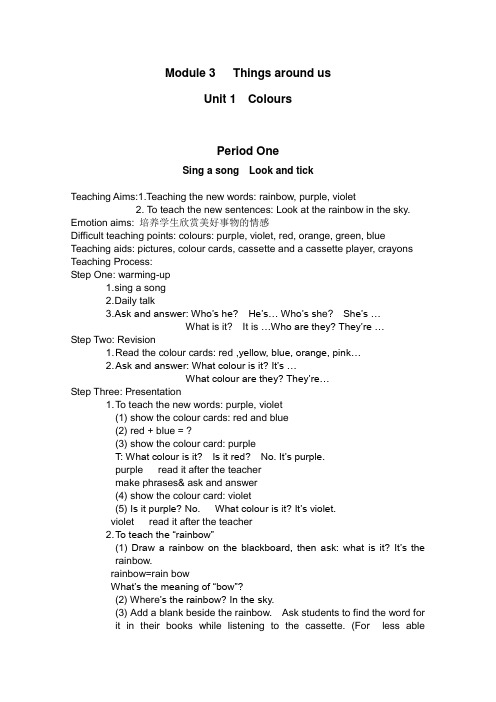
Module 3 Things around usUnit 1 ColoursPeriod OneSing a song Look and tickTeaching Aims:1.Teaching the new words: rainbow, purple, violet2. To teach the new sentences: Look at the rainbow in the sky. Emotion aims: 培养学生欣赏美好事物的情感Difficult teaching points: colours: purple, violet, red, orange, green, blue Teaching aids: pictures, colour cards, cassette and a cassette player, crayons Teaching Process:Step One: warming-up1. s ing a song2. D aily talk3. A sk and answer: Who’s he? He’s… Who’s sh e? She’s …What is it? It is …Who are they? They’re …Step Two: Revision1. Read the colour cards: red ,yellow, blue, orange, pink…2. Ask and answer: What colour is it? It’s …What colour are they? They’re…Step Three: Presentation1. To teach the new words: purple, violet(1) show the colour cards: red and blue(2) red + blue = ?(3) show the colour card: purpleT: What colour is it? Is it red? No. It’s purple.purple read it after the teachermake phrases& ask and answer(4) show the colour card: violet(5) Is it purple? No. What colour is it? It’s violet.violet read it after the teacher2. To teach the “rainbow”(1) Draw a rainbow on the blackboard, then ask: what is it? It’s therainbow.rainbow=rain bowWhat’s the meaning of “bow”?(2) Where’s the rainbow? In the sky.(3) Add a blank beside the rainbow. Ask students to find the word forit in their books while listening to the cassette. (For less ablestudents, write the letter r for them as a clue)What colour is therainbow? Red, orange, yellow, green, blue, purple and violet.3. Play the cassette. Students listen.4. Invite the students to fill in the blank,5. Play the cassette again. Students sin along.6. Ask the students to draw a rainbow on their own paper and colour ituse the crayons. Play the cassette for the third time.Step Four: Sing a song<The Rainbow> Act out this song.Step Five: Look and tick1.Ask students to look at eh picture on page 29 of the book and tick thecolour boxes.2. Students to check answers.Step Five: Consolidation1. Read “the rainbow”2. Students discuss the colour of the objects around them. Students use:What colour is it? to elicit It’s … in the discuss3. form every two pairs of students into a group. Encourage students toask: What colour is your…? To elicit: It’s …or It’s …and…Step Six: Homework1. Listen to the tape2. Sing a song<The Rainbow>Period TwoLook and say Ask and answerTeaching Aims: 1. Words: sea, mountain2. Ask and answer:What colour is the_____? It’s ______.What colour are the_____? They’re______.Emotion aims: 培养学生对大自然的热爱Difficult teaching points: What colour are … They’re…and…Teaching aids: pictures, colour cards, cassette and a cassette playerTeaching Process:Step One: Warming –up1. Sing a song<The Rainbow>2. Listen and choose: ( Look at the picture above, then choose thecolours.)Step Two: Revision1. Read the colours: red, green, grey…2. Drills: What’s this? It’s a ____. What colour is it? It’s _____What are they? They’re______. Who’s he/she?He’s/She’s____.Step Three: Presentation1. Teaching “mountain, sea”(1)T: Draw a mountain on the board. Look at the picture. What’s this?Oh, it’s a mountain.Write “mountain” on the board.(2)Say after the teacher(3)Colour the mountain and say: This is a mountain. I like themountain. The mountain is green. The mountain is nice.(4)The same way: sea2. Draw the picture on the board. Add a blank beside each object. Askthe students to find the correct word and fill in the blanks.3. Play the cassette. Students listen .4. Point to the picture on the board. Ask :What colour is / arethe …?Students answer by looking at the picture in the book. Colourthat object on the board with a piece of coloured chalk.(1)Point to the pictureT: What’s this? P: It’s a mountain.T: What colour is the mountain? P: It’s green.T: What colour are the clouds? They’re grey and white.(2)Play the cassette again. Students repeat.(3)Invite a few students to come to the board. Encourage them to askany classmate: What colo ur is/are the…? To elicit:It’s/They’re…Step Four: Ask and answer1. Students work in pairs to discuss the picture. Students take turns toask another the colour of all the objects on the picture. Students ask:What colour is/are …? To elitic: It’s/They’re …2. Studens work in groups to discuss the objects around them. Askand answers.Step Four: Consolidation1. Workbook page17(exercise2)(1) Complete the exercise with the class orally(2) Students fill in the blanks(3) Students work in pairs to check answers by asking and answering.2. Workbook page 18(1) Review the words given by asking students to draw them on theboard.(2) Fill in the blanks and colour the picture.(3) Students work in groups to check the answer.3. Grammar Practice Book P30: Look , write and colourStep Four: Homework1. Listen to the tape2. Draw their own pictures and colour it. Ask and answerPeriod ThreeLook and learn Read and guess Learn the soundTeaching aims: 1.words: blouse, T-shirt, shirt2. New sentences: He has …. She has ….3. Ask and answer: Who is he? He’s…Who is she? She’s…4. Learn the sound: /D /Emotion aims: 培养学生仔细观察的良好习惯Difficult teaching points: He has…She has…Teaching aids: pictures, paper, crayons, cassette and a cassette player Teaching Process:Step One: Warming-up1. Sing a song2. Listen and act3. Daily talkStep Two: RevisionAsk and answer:What colour is the…? It’s …What colour are the …? T hey’re …Step Three: Presentation1.( Show a picture of dress)(1)T: Look, this is a dress. It’s very nice. I like it very much. Have yougot a dress?dress say it after the teacher(2)Make some phraseseg. a red dress a red and yellow dress(3)Make some sentences with “dress”e.g. This is a dress. My dress is red. I have a dress.(4)Introduce: blouse, T-shirt, shirt(5)Say the words togeter2.Read and guess(1)T: (Point to one girl) Have you a dress? S1:Yes.T: What colour is it? S1: It is red and white.T: She has a dress. She has a red and white dress.(2)T: (Point to one boy) Have you a T-shirt? S2: Yes.T: What colour is it? S2: It is blue and purple.T: He has not a dress. He has a T-shirt. He has a blue and purpleT-shirt.(3)Work in pairs.(4) Play the cassette. Students listen.(5) Guess: She has a … Who is she? She’s…He has a … Who is he ? He’s…(6) Tell students that they are going to prepare for a children’sfashion show. Divide students into groups. Ask students to drawthe clothes and colour them, then cut them out. Put the colthes onthe paper boy or girl.Encourage students to introduce their model by saying:This is … She/He has a …3. Learn the soundStep Four: Consolidation1. Encourage students draw new models and design new clothes forthe fashion show. Introduce their own models.2. Introduce: My mother has… My father has…3. Ask students to draw their friend on the paper. Ask students to puttheir friend’s name in the first sentence and describe their friend’sclothes in the second sentence.Step Five: Homework1. Copy the new words: dress, blouse, T-shirt, shirt2. Divide students into groups. Ask them to use the pictures ormagazines.Provide each group with cards and paper3. Write a few sentences to describe the clothes.。
【教育学习文章】牛津小学英语3B全册第10单元教案

牛津小学英语3B全册第10单元教案牛津小学英语3B第10单元教案一教学内容牛津小学英语3B第10单元二教学目标、能正确地听、说、读、写字母Uu,Vv,ww.2、能听懂、会说乐器和球类单词:apiano,aviolin,aguitar,anaccordion,football,basketb all,volleyball,baseball及其词组play….3、能听懂、会说日常交际用语Doyouplay…?Doyoulike…?yes,Ido./No,Idon’t.whatdoyouplay?Iplay….Great!并能熟练运用日常交际用语进行问答。
4、能区分球类和乐器的表述方法,并能熟练运用。
5、欣赏歌曲westudyandplay.三教学重点能正确地听、说、读、写字母Uu,Vv,ww.2、能听懂、会说乐器和球类单词及其词组。
3、能听懂、会说日常交际用语Doyouplay…?Doyoulike…?yes,Ido./No,Idon’t.whatdoyouplay?Iplay…Great!并能熟练运用日常交际用语进行问答。
四教学难点、能区分球类和乐器的表述方法,并能熟练运用。
2、初步感知第三人称单数的用法。
3B第十单元第一课时一、教学内容:牛津小学英语3B第十单元第一课时二、教学目标:、能听懂、会说日常交际用语:Doyoulikefootball?whatdoyoulike?以及相应的回答yes,Ido./No,Idon’t.2、能听懂、会说球类的单词:football,volleyball,baseball,basketball.渗透:Pingpong.3、了解某人的喜好。
4、能够朗读课文。
5、学会创新三、教学重点:单词的朗读及能在情景中运用句型:Doyoulike….whatdoyoulike?四、教学难点:whatdoyoulike?以及相应的回答yes,Ido./No,Idon’t.五、课前准备:、磁带及录音机。
牛津小学英语 3B第二单元教案

牛津小学英语 3B第二单元教案第一教时教学内容:《牛津小学英语》3B第二单元第一教时教学目标:1、学生能熟练掌握clock key computer 这三个单词。
2、学生能熟练运用一般疑问句Is this /that …?并能进行肯定和否定的回答Yes,it is . No, it isn’t.3、能正确地使用感叹句What a nice…对物品进行赞美。
4、能正确地使用礼貌用语May I come e in,please.教学重点:1、单词:clock key computer2、能运用Is this /that ?Yes,it is . No, it isn’t.进行问答。
教学难点:Is this /that …?Yes,it is .No, it isn’t. 及单词的正确读音。
课前准备:教师和学生都应该准备一些彩色的礼物盒。
礼物盒里面准备一些学生学过的一些漂亮物品作为礼物。
同时教时还应该准备钥匙、钟、电脑的实物或图片。
教学过程:1、Free Talk and Revisiona教师运用学生学过的问候语与学生进行每日英语交流。
帮助学生复现学过的知识。
T: Hello everyone! How are you?S: Fine, thank you . And you?T: I’m fine ,too.T: I’m very happy today.b、猜谜游戏(教师通过学生在第一单元中学过的句型复习已经学过的单词)T: Excuse me, what’s this in the box?S: It’s a …2、 Presentation and Practicea (一名学生稍晚进教室教师课前指导学生完成)S:May I come in?T: Come in , please. Sit down, please.S : Thank you.(一名学生捧着作业本进教室教师课前指导学生完成)S:May I come in?T: Come in , please. (教师引导学生应答)教师创设情境让学生在情境中明确May I come in? Come in,please.的意思。
3B教案
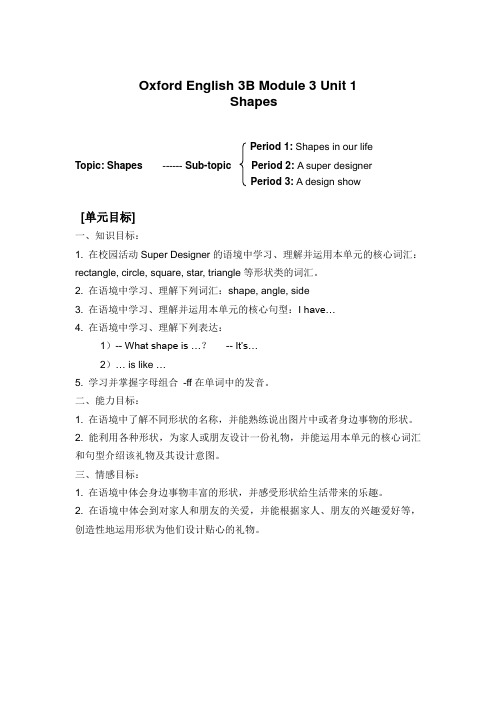
Oxford English 3B Module 3 Unit 1ShapesPeriod 1: Shapes in our lifeTopic: Shapes------ Sub-topic Period2: A super designerPeriod3: A design show[单元目标]一、知识目标:1. 在校园活动Super Designer的语境中学习、理解并运用本单元的核心词汇:rectangle, circle, square, star, triangle等形状类的词汇。
2. 在语境中学习、理解下列词汇:shape, angle, side3. 在语境中学习、理解并运用本单元的核心句型:I have…4. 在语境中学习、理解下列表达:1)-- What shape is …?-- It’s…2)… is like …5. 学习并掌握字母组合-ff在单词中的发音。
二、能力目标:1. 在语境中了解不同形状的名称,并能熟练说出图片中或者身边事物的形状。
2. 能利用各种形状,为家人或朋友设计一份礼物,并能运用本单元的核心词汇和句型介绍该礼物及其设计意图。
三、情感目标:1. 在语境中体会身边事物丰富的形状,并感受形状给生活带来的乐趣。
2. 在语境中体会到对家人和朋友的关爱,并能根据家人、朋友的兴趣爱好等,创造性地运用形状为他们设计贴心的礼物。
[分课时教学目标][第二课时教学设计]一、教学目标1. 在语篇语境中进一步学习和理解本单元的核心词汇:rectangle, circle, square,star, triangle和核心句型:I have…2. 能用核心词汇和句型,结合已有的旧知,描述为朋友设计的礼物及设计意图。
3. 通过语篇学习,体会朋友间的关爱,感受生活中事物富有形状的乐趣,初步具有创造性设计礼物的意识。
4. 掌握字母组合-ff在单词中的发音规律。
二、重点难点1. 重点:在语境中让学生了解事物的不同形状,并能运用本课时的核心词汇和句型来描述自己设计的礼物。
上海牛津英语3B教案
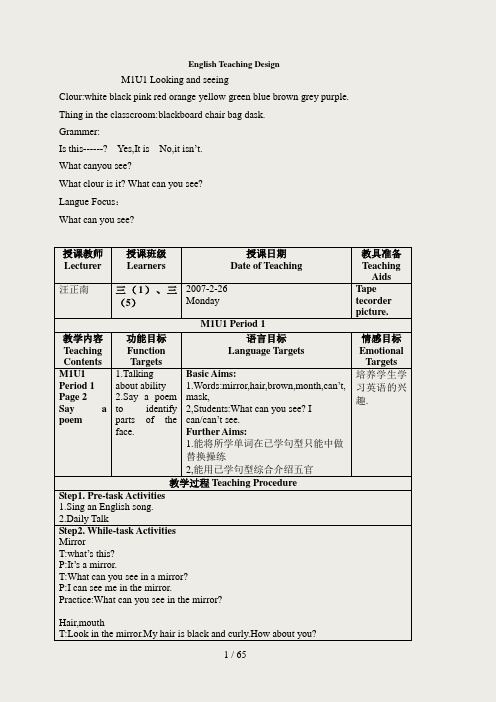
English Teaching DesignM1U1 Looking and seeingClour:white black pink red orange yellow green blue brown grey purple. Thing in the classcroom:blackboard chair bag dask.Grammer:Is this------? Yes,It is No,it isn’t.What canyou see?What clour is it? What can you see?Langue Focus:What can you see?授课教师Lecturer 授课班级Learners授课日期Date of Teaching教具准备TeachingAids汪正南三(1)、三(5)2007-2-26MondayTapetecorderpicture.M1U1 Period 1教学内容Teaching Contents 功能目标FunctionTargets语言目标Language Targets情感目标EmotionalTargetsM1U1 Period 1 Page 2 Say a poem 1.Talkingabout ability2.Say a poemto identifyparts of theface.Basic Aims:1.Words:mirror,hair,brown,month,can’t,mask,2,Students:What can you see? Ican/can’t see.Further Aims:1.能将所学单词在已学句型只能中做替换操练2,能用已学句型综合介绍五官培养学生学习英语的兴趣.教学过程Teaching ProcedureStep1. Pre-task Activities1.Sing an English song.2.Daily TalkStep2. While-task ActivitiesMirrorT:what’s this?P:It’s a mirror.T:What can you see in a mirror?P:I can see me in the mirror.Practice:What can you see in the mirror?Hair,mouthT:Look in the mirror.My hair is black and curly.How about you?Nose,eyesP:Look in the mirror.My hair is black.My eyes are big.T:Say sth about your self in the mirror.Eg:My eyes are……My noses are……I can see -------------T:Look at the desk.What can you see on the desk?I can’t see------------P:Icansee two pens on the desk.T:What can’t you see on the desk?P:I can’t see two bags on it.Ask and answer with your partner.Step3. Post-task ActivitiesSay a poem.1.Listen to the poem.2.Say a poem like it about yourself.Eg:Look in the mmirror.What can you see?(I can see a girl/boy) Black/long hairTwo big(bright)eyes.One noses.Two ears and a mouthI can see me.课后作业Assignments板书设计1.Listen to the tape.2.Recite the poem. Look in the mirror.What can you see?Black hair,two brown eyes, one nose,two ears and a mouth .I can see me.课堂记录Notes of Imperfection课后反思Reconsideration M1U1 Period2授课教师Lecturer 授课班级Learners授课日期Date of Teaching教具准备TeachingAids汪正南三(1)、三(5)2007-2-27Tuesday Tape ecorder picture教学目标教学内容Teaching Contents功能目标Function Targets语言目标Language Targets情感目标EmotionalTargetsM1U1In the classroom 1.Talking aboutWhat can you seeingtpredicativeadjectivesof colour to describethings.Basic Aims:1.Words:chair,ruler,rubber,bag,pen,blackboard,pink,white,red,organge.2.Structures:What can you see?What colouris it?It’s……Further Aims:能用所学单词在已学句型:What can you see? I can/can’tsee……What colour is it?中替换操练。
上海牛津英语3BM2U1教案

上海牛津英语3BM2U1教案教材信息教材:上海牛津英语3BM2U1教材主题:Arranging a Trip课时数:2适用年级:三年级教学目标1.学生能够通过听、说、读、写的方式掌握关于旅行的词汇和句型;2.学生能够运用所学内容介绍并讨论旅行的计划;3.学生能够通过与同伴的合作学习发展他们的合作能力和沟通能力;4.学生能够通过观看视频等多媒体资源拓宽他们的视野。
教学过程一、引入1.观看一个短视频,介绍教学主题,激发学生的学习兴趣,并进入教学主题。
2.教师可以出示一些旅行的图片,引导学生用所学到的单词描述这些图片。
二、新知呈现1. 教师用图片或幻灯片大屏幕展示一些旅行的地点,引导学生用“What do you think of...”的句式来描述图片。
2. 教师用“Where do you want to go?”的句式提问学生,激发学生的参与和发言。
3. 通过与学生的互动,教师以“What are you going to do there?”的句式引导学生运用所学的词汇进行回答。
4.教师以同样的方式,呈现其他一些旅行地点和活动,引导学生进行讨论和描述。
三、合作学习1. 学生分组合作,每组选一个地点,并用“Where do you want to go? What are you going to do there?”等问句和答句来展示讨论结果。
2.教师可以提供一些关于旅行目的地的介绍的简短句子,供学生参考。
四、巩固练习1.学生在小组内互相交换他们计划的旅行目的地和活动,并互相提问和回答,以巩固所学的句型和词汇。
2.学生可以用所学的句型和词汇写一张明信片,向同学介绍他们计划的旅行。
五、拓展延伸1.观看关于旅行的视频或读一篇关于旅行的文章,进一步了解不同地方和文化。
2.学生可以为自己的计划旅行地点制作一个小宣传册,包括旅行目的地的介绍、活动、当地美食等,以拓宽他们的视野,并提高他们的作文能力。
评估与反馈1.教师观察学生在讨论和描述旅行计划时的表现,并对其进行评价和反馈。
上海沪教牛津版英语3B三年级上册教案备课

上海沪教牛津版英语3B三年级上册教案
备课
教学目标
通过教学本课内容,学生将会:
- 能够听、说、读、写本课的单词
- 能够正确地使用介词 in 和 on
- 能够描述家人和朋友的外貌特征和爱好
教学重点
- 本课的单词
- 介词 in 和 on 的正确使用
- 描述家人和朋友的能力
教学难点
- 是否能够正确地使用介词 in 和 on
- 是否能够描述家人和朋友的外貌特征和爱好
教学准备
- 教师准备图片,大拇指卡片或其他卡片展示外貌特征及爱好。
教学过程
Step 1 导入新课
教师出示大拇指卡片,通过展示图片让学生猜测人物的外貌特征。
Step 2 讲授重点内容
介绍本课的单词及介词 in 和 on的正确使用。
2.1 单词研究
教师逐一为学生介绍本课的单词,带领学生研究单词的读音和意义。
2.2 介词使用
通过举例子的方式讲解 in 和 on 的正确使用方法。
Step 3 进行练
教师出示卡片上的图片,让学生描述卡片上人物的外貌特征和爱好。
Step 4 归纳总结
总结本课所学的内容,再次强化学生对单词及介词 in 和 on 的理解。
课堂作业
完成课堂练册的相关练。
参考资料
- 英语3B上册教材
- 英语3B上册教师用书。
《牛津小学英语3B》教案

《牛津小学英语3B》教案一、教学目标1、让学生能够熟练掌握本单元的重点单词,如“father, mother, brother, sister”等。
2、使学生能够运用简单的句型进行日常的交流,例如“ This is my ”。
3、培养学生对英语的学习兴趣,提高他们的口语表达能力。
二、教学重难点1、重点掌握本单元的核心单词和句型。
能够准确地发音,并理解单词和句型的含义。
2、难点灵活运用所学句型介绍自己的家庭成员。
区分家庭成员的称呼在英语中的不同表述。
三、教学方法1、情景教学法通过创设家庭聚会等情景,让学生在实际情境中学习和运用英语。
2、游戏教学法设计有趣的英语游戏,如“单词接龙”“猜家庭成员”等,增加学习的趣味性。
3、小组合作学习法组织学生进行小组活动,互相交流和练习,培养合作能力和口语表达能力。
四、教学过程1、导入(Warming up)播放一首欢快的英文歌曲《The Finger Family》,让学生跟着歌曲一起唱,同时引导学生注意歌曲中提到的家庭成员。
提问学生:“Do you know the names of your f amily members in English?” 引发学生的兴趣和思考。
2、词汇学习(Vocabulary)展示一张家庭照片,指着照片中的人物,依次介绍单词“father, mother, brother, sister”等,让学生跟着重复。
玩“闪卡游戏”,快速展示单词卡片,让学生迅速说出单词,巩固记忆。
3、句型学习(Sentence Patterns)教师指着自己的全家福,说:“This is my father This is my mother”引导学生理解句型的意思和用法。
让学生拿出自己准备的家庭照片,用句型“This is my”向同桌介绍自己的家庭成员。
4、对话练习(Dialogue Practice)创设一个家庭聚会的情景,让学生分组进行角色扮演,模仿家庭成员之间的交流。
牛津小学英语3B教案(全册)教案

三年级下册牛津小学英语3B第一单元教案第一课时一、教学内容《牛津小学英语》3B第一单元第一课时二、教学目标1、能听懂、会说文具玩具类单词a school bag, a crayon, a tape, a knife2、能听懂、会说日常交际用语What’s this/ that in English? It’s…(由于本单元内容较多,对于三年级学生而言,有一定困难,故作一定调整。
三、四两图安排在第一教时,一二两图安排在第二教时。
)3、能使用礼貌用语Excuse me.三、教学重点1、能听懂、会说文具玩具类单词a school bag, a crayon, a tape, a knife四、教学难点1、能听懂、会说文具玩具类单词a school bag, a crayon, a tape, a knife2、能听懂、会说日常交际用语What’s this/ that in English? It’s…Excuse me.并获得运用语言进行交际的能力,要求读音正确,语调自然。
五、课前准备教具准备:课前准备本课的文具玩具图片和实物若干。
人物图片(Yang Ling, Gao Shan.)及磁带录音机,教学挂图。
六、教学过程Step1. Free talk:1.师生用Good morning/afternoon. How are you?互相问候。
2.引导学生用What’s your name?互问姓名,练习“what’s”。
3. 出示本课的人物图片,示范:This is Yang Ling. That’s Gao Shan.出示水果类图片,引导学生用This is a... That’s a ... It’s a...造句。
Step2. Presentation and practice1、出示文具类图片(pen, book等学过的单词)让学生造句:This is a... That’s a... It’s a...2、出示一只书包T: What’s this?S: A bag.T: It’s a school bag.出示单词 a school bag 并领读S:跟读T: What’s this in English?S: It’s a school bag.出示词组in English 并领读S:跟读T:What’s this in English?S: 跟读。
上海牛津英语3B复习教案
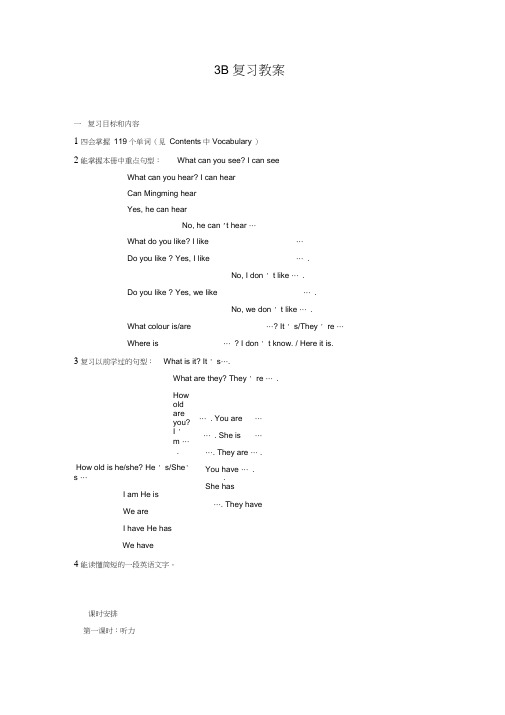
3B 复习教案一 复习目标和内容1四会掌握 119个单词(见 Contents 中Vocabulary )2能掌握本册中重点句型: What can you see? I can seeWhat can you hear? I can hearCan Mingming hearYes, he can hearNo, he can ' t hear …What do you like? I like… Do you like ? Yes, I like … .No, I don ' t like … .Do you like ? Yes, we like … .No, we don ' t like … .What colour is/are…? It ' s/They ' re … Where is … ? I don ' t know. / Here it is.3复习以前学过的句型: What is it? It ' s ….What are they? They ' re … .Howoldare you?I ' m …. How old is he/she? He ' s/She 's …. I am He isWe areI have He hasWe have 4能读懂简短的一段英语文字。
课时安排第一课时:听力… . You are … … . She is … …. They are … .You have … . She has …. They have第二课时:复习四会单词、重点句型及其相应变化。
第三课时:复习四会单词、重点句型、熟悉相关的问答句。
第四课时:能正确抄写句子、能看懂短文的意思完成练习。
第一课时目标:能将听到的单词、词组、句子圈出;听录音,将单词填写完 整;听录音,看图判断正误;听录音,填写短文所缺的单词; 听问句,圈出正确的问答句。
